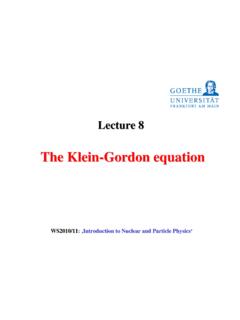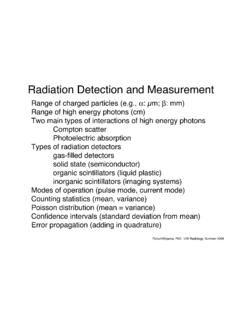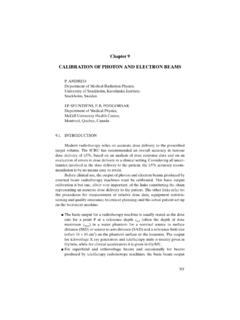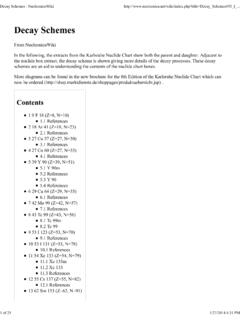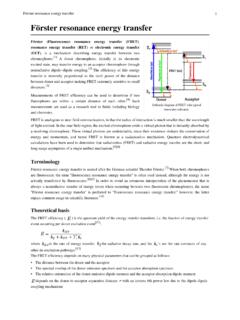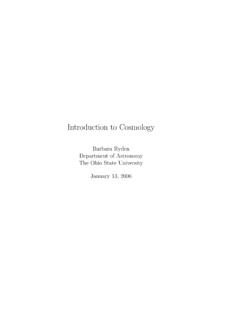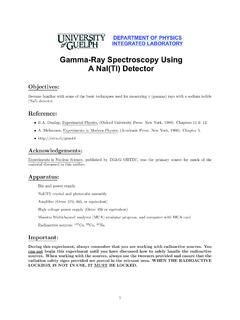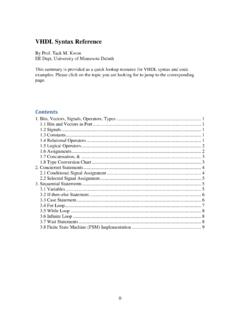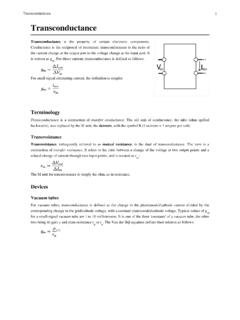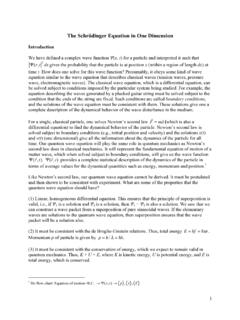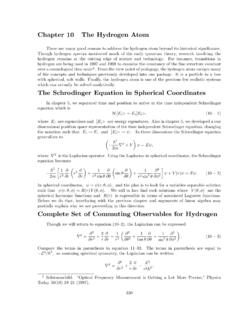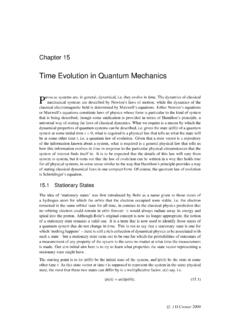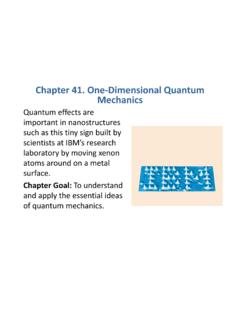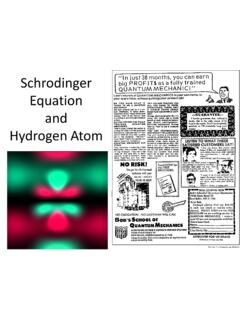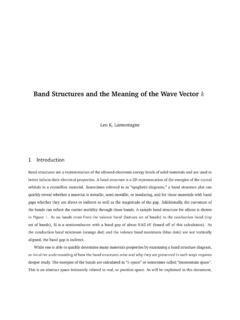Transcription of Schrödinger equation - University of Arizona
1 Schr dinger equation 1. Schr dinger equation In physics, specifically quantum mechanics, the Schr dinger equation , formulated in 1926 by Austrian physicist Erwin Schr dinger, is an equation that describes how the quantum state of a physical system changes in time. It is as central to quantum mechanics as Newton's laws are to classical mechanics. Two forms of the Schr dinger equation In the standard interpretation of quantum mechanics, the quantum state, also called a wavefunction or state vector, is the most complete description that can be given to a physical system. Solutions to Schr dinger's equation describe not only molecular, atomic and subatomic systems, but also macroscopic systems, possibly even the whole universe.
2 [1]. The most general form is the time-dependent Schr dinger equation , which gives a description of a system evolving with time. For systems in a stationary state, ( where the Hamiltonian is not explicitly dependent on time) the time-independent Schr dinger equation is sufficient. Approximate solutions to the time-independent Schr dinger equation are commonly used to calculate the energy levels and other properties of atoms and molecules. Schr dinger's equation can be mathematically transformed into Werner Heisenberg's matrix mechanics, and into Richard Feynman's path integral formulation. The Schr dinger equation describes time in a way that is inconvenient for relativistic theories, a problem which is not as severe in matrix mechanics and completely absent in the path integral formulation.
3 The Schr dinger equation The Schr dinger equation takes several different forms, depending on the physical situation. This section presents the equation for the general case and for the simple case encountered in many textbooks. General quantum system For a general quantum system: [2]. where is the wave function; the probability amplitude for different configurations of the system at different times, is the energy operator ( is the imaginary unit and is the reduced Planck constant), is the Hamiltonian operator. Schr dinger equation 2. Single particle in a potential For a single particle with potential energy V in position space, the Schr dinger equation takes the form:[3].
4 Where is the kinetic energy operator, where m is the mass of the particle. is the Laplace operator. In three dimensions, the Laplace operator is , where x, y, and z are the Cartesian coordinates of space. is the time-independent potential energy at the position r. is the probability amplitude for the particle to be found at position r at time t. is the Hamiltonian operator for a single particle in a potential. Time independent or stationary equation The time independent equation , again for a single particle with potential energy V, takes the form:[4]. This equation describes the standing wave solutions of the time-dependent equation , which are the states with definite energy.
5 Historical background and development Following Max Planck's quantization of light (see black body radiation), Albert Einstein interpreted Planck's quantum to be photons, particles of light, and proposed that the energy of a photon is proportional to its frequency, one of the first signs of wave particle duality. Since energy and momentum are related in the same way as frequency and wavenumber in special relativity, it followed that the momentum p of a photon is proportional to its wavenumber k. Louis de Broglie hypothesized that this is true for all particles, even particles such as electrons. Assuming that the waves travel roughly along classical paths, he showed that they form standing waves for certain discrete frequencies.
6 These correspond to discrete energy levels, which reproduced the old quantum condition.[5]. Following up on these ideas, Schr dinger decided to find a proper wave equation for the electron. He was guided by William R. Hamilton's analogy between mechanics and optics, encoded in the observation that the zero-wavelength limit of optics resembles a mechanical system the trajectories of light rays become sharp tracks which obey Fermat's principle, an analog of the principle of least action.[6] A modern version of his reasoning is reproduced in the next section. The equation he found is: Using this equation , Schr dinger computed the hydrogen spectral series by treating a hydrogen atom's electron as a wave (x, t), moving in a potential well V, created by the proton.
7 This computation accurately reproduced the energy levels of the Bohr model. However, by that time, Arnold Sommerfeld had refined the Bohr model with relativistic corrections.[7] [8]. Schr dinger used the relativistic energy momentum relation to find what is now known as the Klein Gordon Schr dinger equation 3. equation in a Coulomb potential (in natural units): He found the standing waves of this relativistic equation , but the relativistic corrections disagreed with Sommerfeld's formula. Discouraged, he put away his calculations and secluded himself in an isolated mountain cabin with a lover.[9]. While at the cabin, Schr dinger decided that his earlier non-relativistic calculations were novel enough to publish, and decided to leave off the problem of relativistic corrections for the future.
8 He put together his wave equation and the spectral analysis of hydrogen in a paper in 1926.[10] The paper was enthusiastically endorsed by Einstein, who saw the matter-waves as an intuitive depiction of nature, as opposed to Heisenberg's matrix mechanics, which he considered overly formal.[11]. The Schr dinger equation details the behaviour of but says nothing of its nature. Schr dinger tried to interpret it as a charge density in his fourth paper, but he was unsuccessful.[12] In 1926, just a few days after Schr dinger's fourth and final paper was published, Max Born successfully interpreted as a probability amplitude.[13] Schr dinger, though, always opposed a statistical or probabilistic approach, with its associated discontinuities much like Einstein, who believed that quantum mechanics was a statistical approximation to an underlying deterministic theory and never reconciled with the Copenhagen interpretation.
9 [14]. Derivation Short heuristic derivation Schr dinger's equation can be derived in the following short heuristic way. It should be noted that Schr dinger's wave equation was a result of the ingenious mathematical intuition of Erwin Schr dinger, and cannot be derived independently. Assumptions 1. The total energy E of a particle is This is the classical expression for a particle with mass m where the total energy E is the sum of the kinetic energy T, and the potential energy V (which can vary with position, and time). p and m are respectively the momentum and the mass of the particle. 2. Einstein's light quanta hypothesis of 1905, which asserts that the energy E of a photon is proportional to the frequency (or angular frequency, = 2 ) of the corresponding electromagnetic wave: 3.
10 The de Broglie hypothesis of 1924, which states that any particle can be associated with a wave, and that the momentum p of the particle is related to the wavelength (or wavenumber k) of such a wave by: Expressing p and k as vectors, we have 4. The three assumptions above allow one to derive the equation for plane waves only. To conclude that it is true in general requires the superposition principle, and thus, one must separately postulate that the Schr dinger equation is linear. Schr dinger equation 4. Expressing the wave function as a complex plane wave Schr dinger's idea was to express the phase of a plane wave as a complex phase factor: and to realize that since then and similarly since and we find: so that, again for a plane wave, he obtained: And, by inserting these expressions for the energy and momentum into the classical formula we started with, we get Schr dinger's famed equation , for a single particle in the 3-dimensional case in the presence of a potential V: Versions There are several equations that go by Schr dinger's name: Time dependent equation This is the equation of motion for the quantum state.
